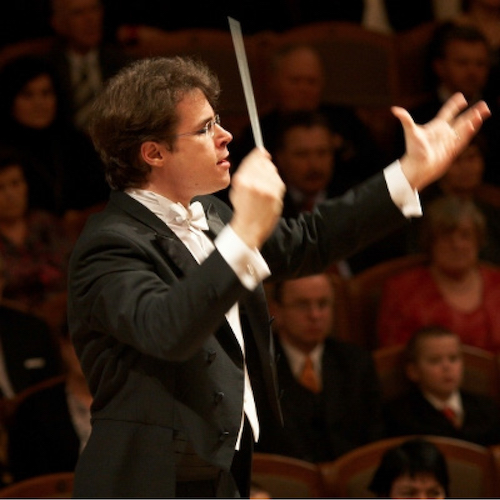by Mike Telin

On Thursday, November 15 at 7:30 pm, Hrůša will keep that tradition alive when he leads The Cleveland Orchestra in Miloslav Kabeláč’s Mystery of Time. “I think he is the most important symphonist of 20th-century Czech music after Martinů,” the conductor said during a telephone interview. The concert will also include Stravinsky’s Capriccio (for piano and orchestra) featuring Emanuel Ax, and Shostakovich’s Symphony No. 5. The program will be repeated on Saturday, November 17 at 8:00 pm, and Sunday November 18 at 3:00 pm. Tickets are available online.
Hrůša noted that the lineage of Czech symphonic composers begins with Dvořák, whom he called the “founder” of that repertoire. “Then you have Smetana, who was not interested in the symphony but wrote symphonic poems. After that is [Zdeněk] Fibich, then Janáček — who never wrote a symphony, then Martinů with his six symphonies. There is always the question of who is next.”
For Hrůša, it’s Kabeláč (1908-1979), whom he once referred to as the greatest composer no one has heard of. “People abroad don’t know about him, and the main reason is that he was kind of locked in the country because of his political opinions. He was interested in the newest developments in music and was never friendly with the official doctrine of the esthetics of the Eastern Bloc. He was often invited to music events in the West, but he never could go or send his pieces because his music was considered ‘unwanted’ in his home country.”
Kabeláč’s output includes eight symphonies and eight orchestral pieces; compositions for solo piano, solo organ, solo voice, and chamber ensembles; choral works, including three cantatas; and electroacoustic music. Hrůša said that A Mystery of Time is a “gateway” into Kabeláč’s music.
“It’s his most popular for sure — it’s slightly less experimental than his other pieces. In my opinion it’s one of the most beautiful examples of what abstract music — music without a particular program — can create in terms of gradation and arc. Musically it’s a simple concept starting from the most minute cell and getting broader, louder, and growing to a climax, then relaxing back into the original state. It’s a depiction of time through musical terms. The feeling I get when I’m conducting it is similar to when we look at the sky and the stars at night. The piece is built in a very natural way, as if little microcosms of music are being created, and the laws of this creation are smooth and natural. I find it very beautiful.”
Hrůša has conducted the work with orchestras in Tokyo, Vienna, and Helsinki and will take it to London for a performance with the Philharmonia Orchestra the week after Cleveland. “I can now say without exaggeration that the piece works. It’s powerful, strong, and the orchestras and audiences react to it amazingly.”
All of the works on this week’s program share at least two things. They are all from the 20th century but none are “new,” and all three composers are from the Eastern Bloc, although Hrůša said they all have very different personalities.
“Shostakovich stayed in the Soviet Union and retained contact with the political officials. Stravinsky decided to emigrate and become a leader in music of the Western world. And then there is Kabeláč, who somehow got stuck in between. He never had the opportunity, power, or the good luck to get out — maybe for personal reasons he didn’t want to.”
Hrůša said that returning to Cleveland is a highlight of his season. “My first time was at Blossom. It was one or two years before I returned, and then I started to visit once a year. I am extremely happy about it, because the quality and atmosphere of the Orchestra is simply amazing — it’s a precious thing.”
This week’s concerts will also mark the first time that Hrůša and Emanuel Ax have worked together. “I do think there was a wish on the part of The Cleveland Orchestra for this collaboration to happen. Of course he is a legend, but I just haven’t had the opportunity to work with him. You can’t meet everyone — it takes time.”
Hrůša also appreciates the variety of repertoire he has been able to conduct in Cleveland. “It’s always a combination of well-known pieces — which create a deeper bond with the orchestra because they already have a lot of experience with that music — and lesser-known works, which are fun to bring. One of my highlights was conducting Martinů’s Parables. Knowing how complex that piece is and to have the Orchestra play it so well — they have the ability to unlock music they haven’t done before.”
Lately, and “paradoxically to all the information we have on the internet,” Hrůša sees that concert programs worldwide are more and more limited to a few pieces that everyone knows. “I think that is very dangerous, and it is fantastic that I can present these stimulating programs in Cleveland.”
Published on ClevelandClassical.com November 13, 2018.
Click here for a printable copy of this article



